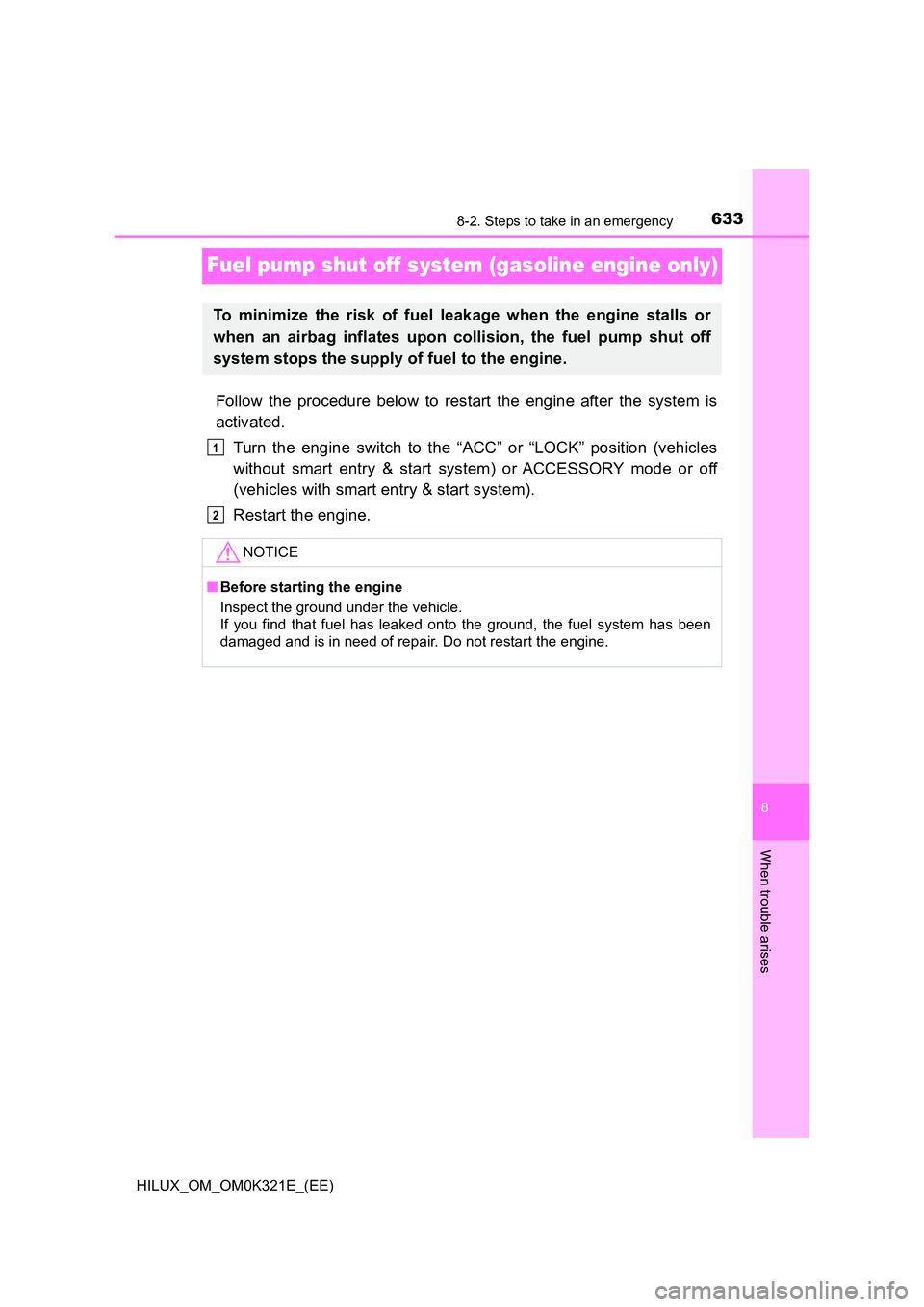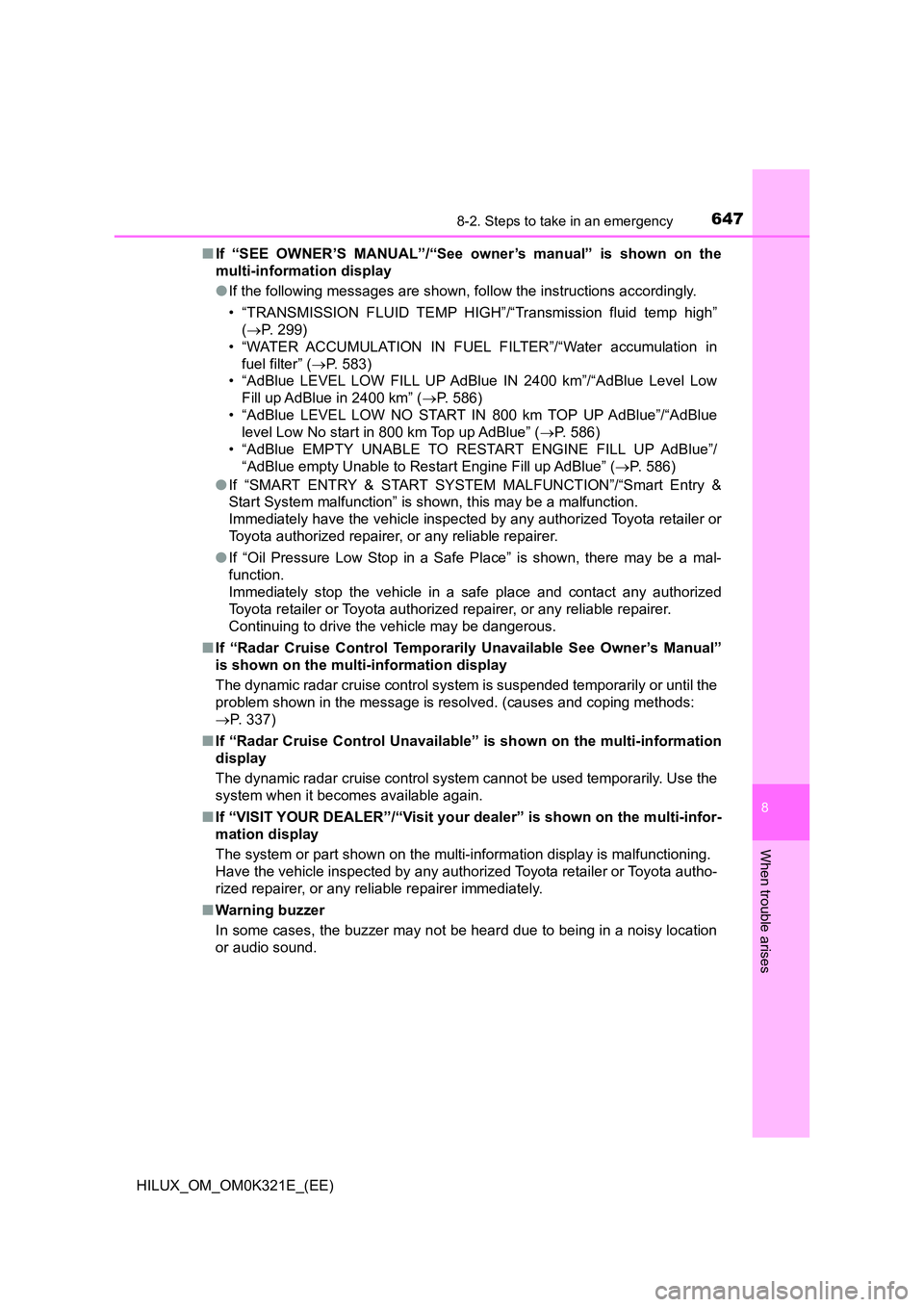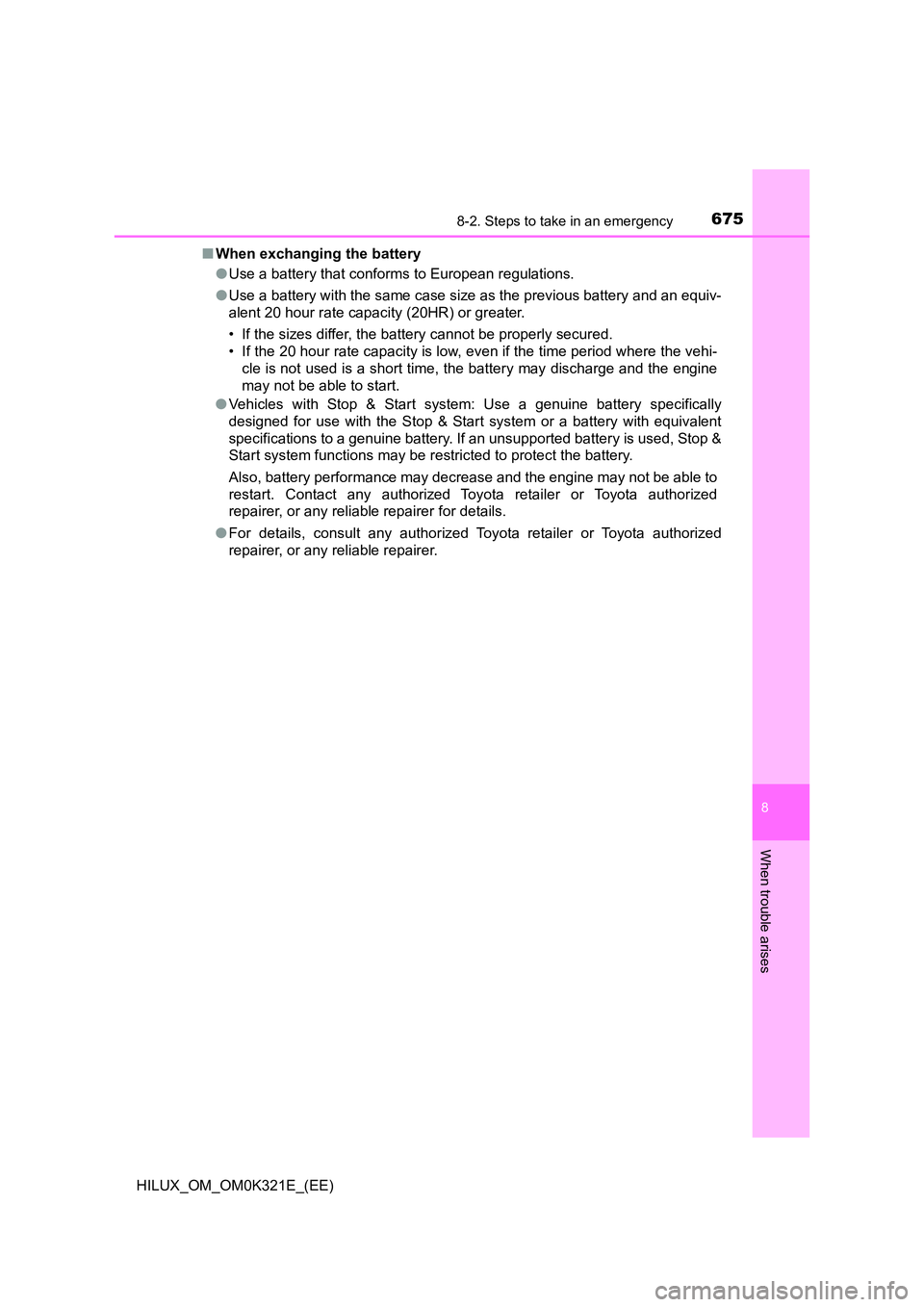2020 TOYOTA HILUX stop start
[x] Cancel search: stop startPage 633 of 744

6338-2. Steps to take in an emergency
HILUX_OM_OM0K321E_(EE)
8
When trouble arises
Fuel pump shut off system (gasoline engine only)
Follow the procedure below to restart the engine after the system is
activated.
Turn the engine switch to the “ACC” or “LOCK” position (vehicles
without smart entry & start system) or ACCESSORY mode or off
(vehicles with smart entry & start system).
Restart the engine.
To minimize the risk of fuel leakage when the engine stalls or
when an airbag inflates upon collision, the fuel pump shut off
system stops the supply of fuel to the engine.
NOTICE
■ Before starting the engine
Inspect the ground under the vehicle.
If you find that fuel has leaked onto the ground, the fuel system has been
damaged and is in need of repair. Do not restart the engine.
1
2
Page 636 of 744

6368-2. Steps to take in an emergency
HILUX_OM_OM0K321E_(EE)
Slip indicator (if equipped)
Indicates a malfunction in:
• The VSC system (if equipped);
• Trailer sway control system (if equipped);
• The TRC/A-TRC system (if equipped);
• The hill-start assist control system (if equipped); or
• The downhill assist control system (if equipped)
Have the vehicle inspected by any authorized Toyota
retailer or Toyota authorized repairer, or any reliable
repairer immediately.
The light will flash when any of the above systems other
than the hill-start assist control system are operating.
Four-wheel drive indicator light (warning buzzer)*3 (if
equipped)
Indicates that the differential oil temperature is too high
when the light flashes rapidly and a buzzer sounds.
Turn the front-wheel drive control switch to H2, and
reduce the vehicle speed or stop the vehicle in a safe
place. ( P. 398)
Indicates a malfunction in the four-wheel drive system
when the light flashes rapidly and a buzzer does not
sound.
Have the vehicle inspected by any authorized Toyota
retailer or Toyota authorized repairer, or any reliable
repairer immediately.
Low speed four-wheel drive indicator light (if equipped)
Indicates a malfunction in the four-wheel drive system
when the light flashes rapidly.
Have the vehicle inspected by any authorized Toyota
retailer or Toyota authorized repairer, or any reliable
repairer immediately.
Rear differential lock indicator light (if equipped)
Indicates a malfunction in the rear differential lock system
when the light flashes rapidly.
Have the vehicle inspected by any authorized Toyota
retailer or Toyota authorized repairer, or any reliable
repairer immediately.
Warning lightWarning light/Details/Actions
Page 639 of 744

6398-2. Steps to take in an emergency
HILUX_OM_OM0K321E_(EE)
8
When trouble arises
Low engine oil level warning light (if equipped)
Indicates that engine oil level is low (This warning light
may come on if the vehicle is stopped on a slope. Move
the vehicle to a level surface and check to see if the light
goes off.)
Check the level of engine oil and add more oil if nec-
essary.
Master warning light (warning buzzer) (if equipped)
A buzzer sounds and the warning light comes on and
flashes to indicate that the master warning system has
detected a malfunction.
P. 643
(Flashes)
Stop & Start cancel indicator (if equipped)
Indicates a malfunction in the Stop & Start system
(The Stop & Start cancel indicator will come on when the
system is canceled: P. 413)
Have the vehicle inspected by any authorized Toyota
retailer or Toyota authorized repairer, or any reliable
repairer immediately.
Parking brake indicator light (warning buzzer)*9
Warns the driver to release parking brake.
Release the parking brake.
Low AdBlue™ level warning light (if equipped)
Indicates that AdBlue™ level is low
Have AdBlue™ refilled at any authorized Toyota
retailer or Toyota authorized repairer, or any reliable
repairer.
Go to service warning light (warning buzzer) (if
equipped)
Indicates a malfunction in the electronic engine control
system or electronic throttle control system, or the Brake
Override System.
Have the vehicle inspected by any authorized Toyota
retailer or Toyota authorized repairer, or any reliable
repairer.
Warning lightWarning light/Details/Actions
Page 646 of 744

6468-2. Steps to take in an emergency
HILUX_OM_OM0K321E_(EE)
■ If “DIFFERENTIAL OIL TEMP HIGH SHIFT TO 2WD MODE COOLING TIME
REQUIRED”/“Differential oil temp high Shift to 2WD mode Cooling time
required” or “DIFFERENTIAL OIL TEMP HIGH COOLING TIME
REQUIRED”/“Differential oil temp high Cooling time required” is shown
on the multi-information display
The differential oil temperature is too high.
Turn the front-wheel drive control switch to H2, and reduce the vehicle speed
or stop the vehicle in a safe place. ( P. 398)
■ If “ENGINE OIL LEVEL LOW ADD OR REPLACE”/“Engine oil level low
Add or replace” is shown on the multi-information display
The engine oil level is low. (This warning message may be displayed if the
vehicle is stopped on a slope. Move to a level surface and check to see if the
message goes off.)
Check the level of the engine oil and add or replace oil if necessary.
( P. 563)
■ If “POWER TURNED OFF TO SAVE BATTERY”/“Power turned off to save
battery” is shown on the multi-information display
Power was turned off due to the automatic power off function.
Next time when starting the engine, increase the engine speed slightly and
maintain that level for approximately 5 minutes to recharge the battery.
■ If “DPF FULL MANUAL REGENERATION REQUIRED SEE OWNER’S
MANUAL”/“DPF full Manual regeneration required See owner’s manual”
is shown on the multi-information display
The deposit collected in the filter needs to be regenerated.
P. 433
■ If “Front Camera Unavailable” or “Front Camera Temporarily Unavailable
See Owner’s Manual” is shown on the multi-information display
The following systems may be suspended until the problem shown in the
message is resolved. ( P. 337, 634)
● PCS (Pre-Collision System)
● LDA (Lane Departure Alert with Yaw Assist Function)
● RSA (Road Sign Assist)
● Dynamic radar cruise control
■ If a message that indicates the need for the shift lever operation is
shown on the multi-information display
To prevent the shift lever from being operated incorrectly or the vehicle from
moving unexpectedly, a message that requires shifting the shift lever may be
shown on the multi-information display. In that case, follow the instruction of
the message and shift the shift lever.
Page 647 of 744

6478-2. Steps to take in an emergency
HILUX_OM_OM0K321E_(EE)
8
When trouble arises
■If “SEE OWNER’S MANUAL”/“See owner’s manual” is shown on the
multi-information display
● If the following messages are shown, follow the instructions accordingly.
• “TRANSMISSION FLUID TEMP HIGH”/“Transmission fluid temp high”
( P. 299)
• “WATER ACCUMULATION IN FUEL FILTER”/“Water accumulation in
fuel filter” ( P. 583)
• “AdBlue LEVEL LOW FILL UP AdBlue IN 2400 km”/“AdBlue Level Low
Fill up AdBlue in 2400 km” ( P. 586)
• “AdBlue LEVEL LOW NO START IN 800 km TOP UP AdBlue”/“AdBlue
level Low No start in 800 km Top up AdBlue” ( P. 586)
• “AdBlue EMPTY UNABLE TO RESTART ENGINE FILL UP AdBlue”/
“AdBlue empty Unable to Rest art Engine Fill up AdBlue” (P. 586)
● If “SMART ENTRY & START SYSTEM MALFUNCTION”/“Smart Entry &
Start System malfunction” is shown, this may be a malfunction.
Immediately have the vehicle inspected by any authorized Toyota retailer or
Toyota authorized repairer, or any reliable repairer.
● If “Oil Pressure Low Stop in a Safe Place” is shown, there may be a mal-
function.
Immediately stop the vehicle in a safe place and contact any authorized
Toyota retailer or Toyota authorized repairer, or any reliable repairer.
Continuing to drive the vehicle may be dangerous.
■ If “Radar Cruise Control Temporarily Unavailable See Owner’s Manual”
is shown on the multi-information display
The dynamic radar cruise control system is suspended temporarily or until the
problem shown in the message is resolved. (causes and coping methods:
P. 337)
■ If “Radar Cruise Control Unavailable” is shown on the multi-information
display
The dynamic radar cruise control system cannot be used temporarily. Use the
system when it becomes available again.
■ If “VISIT YOUR DEALER”/“Visit your dealer” is shown on the multi-infor-
mation display
The system or part shown on the multi- information display is malfunctioning.
Have the vehicle inspected by any authorized Toyota retailer or Toyota autho-
rized repairer, or any reliable repairer immediately.
■ Warning buzzer
In some cases, the buzzer may not be heard due to being in a noisy location
or audio sound.
Page 671 of 744

6718-2. Steps to take in an emergency
HILUX_OM_OM0K321E_(EE)
8
When trouble arises
■Stopping the engine
Shift the shift lever to P (automatic transmission) or N (manual transmission)
and press the engine switch as you normally do when stopping the engine.
■ Replacing the key battery
As the above procedure is a temporary measure, it is recommended that the
electronic key battery be replaced immediately when the battery is depleted.
( P. 599)
■ Alarm (vehicles with alarm for Kazakhstan, Armenia and Morocco)
Using the mechanical key to lock the doors will not set the alarm system.
If a door is unlocked using the mechanical key when the alarm system is set,
the alarm may be triggered.
■ Changing engine switch modes
Release the brake pedal (automatic transmission) or clutch pedal (manual
transmission) and press the engine switch in step above.
The engine does not start and modes will be changed each time the switch is
pressed. ( P. 288)
■ When the electronic key does not work properly
● Make sure that the smart entry & start system has not been deactivated in
the customization setting. If it is off, turn the function on.
(Customizable features: P. 718)
● Check if battery-saving mode is set. If it is set, cancel the function.
( P. 199)
3
Page 674 of 744

6748-2. Steps to take in an emergency
HILUX_OM_OM0K321E_(EE)
Once the vehicle’s engine has started, remove the jumper cables in
the exact reverse order from which they were connected.
Once the engine starts, have the vehicle inspected at any authorized
Toyota retailer or Toyota authorized repairer, or any reliable repairer
as soon as possible.
■ Starting the engine when the battery is discharged (vehicles with auto-
matic transmission)
The engine cannot be started by push-starting.
■ To prevent battery discharge
● Turn off the headlights and the audio system while the engine is off.
(Vehicles with Stop & Start system: Except when the engine is stopped due
to the Stop & Start system)
● Turn off any unnecessary electrical components when the vehicle is running
at a low speed for an extended period, such as in heavy traffic.
■ When the battery is removed or discharged
● Information stored in the ECU is cleared. When the battery is depleted, have
the vehicle inspected at any authorized Toyota retailer or Toyota authorized
repairer, or any reliable repairer.
● The power windows may not close normally. In this case, initialize the power
windows. (if equipped) ( P. 250)
■ Charging the battery
The electricity stored in the battery will discharge gradually even when the
vehicle is not in use, due to natural discharge and the draining effects of cer-
tain electrical appliances. If the vehicle is left for a long time, the battery may
discharge, and the engine may be unable to start. (The battery recharges
automatically during driving.)
■ When recharging or replacing the battery (vehicles with smart entry &
start system)
● In some cases, it may not be possible to unlock the doors using the smart
entry & start system when the battery is discharged. Use the wireless
remote control or the mechanical key to lock or unlock the doors.
● The engine may not start on the first attempt after the battery has recharged
but will start normally after the second attempt. This is not a malfunction.
● The engine switch mode is memorized by the vehicle. When the battery is
reconnected, the system will return to the mode it was in before the battery
was discharged. Before disconnecting the battery, turn the engine switch off.
If you are unsure what mode the engine switch was in before the battery dis-
charged, be especially careful when reconnecting the battery.
● Vehicles with Stop & Start system: After the battery terminals have been dis-
connected and reconnected or, the battery has been replaced, the Stop &
Start system may not automatically stop the engine for approximately 5 to
60 minutes.
6
Page 675 of 744

6758-2. Steps to take in an emergency
HILUX_OM_OM0K321E_(EE)
8
When trouble arises
■When exchanging the battery
● Use a battery that conforms to European regulations.
● Use a battery with the same case size as the previous battery and an equiv-
alent 20 hour rate capacity (20HR) or greater.
• If the sizes differ, the battery cannot be properly secured.
• If the 20 hour rate capacity is low, even if the time period where the vehi-
cle is not used is a short time, the battery may discharge and the engine
may not be able to start.
● Vehicles with Stop & Start system: Use a genuine battery specifically
designed for use with the Stop & Start system or a battery with equivalent
specifications to a genuine battery. If an unsupported battery is used, Stop &
Start system functions may be restricted to protect the battery.
Also, battery performance may decrease and the engine may not be able to
restart. Contact any authorized Toyota retailer or Toyota authorized
repairer, or any reliable repairer for details.
● For details, consult any authorized Toyota retailer or Toyota authorized
repairer, or any reliable repairer.